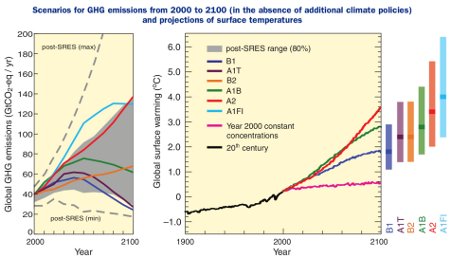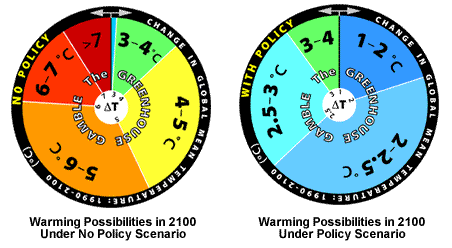“In a worst-case scenario, where no action is taken to check the rise in greenhouse gas emissions, temperatures would most likely rise by more than 5°C by the end of the century.”
—Dr. Vicky Pope, head of climate change predictions at the UK’s Hadley Centre, Dec. 2008
“Without a change in policy, the world is on a path for a rise in global temperature of up to 6°C.”
—International Energy Agency, World Energy Outlook, Nov. 2008 [traditionally a very conservative agency]
“We are on the precipice of climate system tipping points beyond which there is no redemption.”
—James Hansen, director, Goddard Institute for Space Studies (NASA), December 2005
One year ago in a previous post, I thought these types of projections were alarmist and unwarranted. Since then, I’ve found steadily more people suggesting similarly dramatic numbers. Many believe that an average global warming of 1°C is unavoidable, and some claim that—if we do nothing to stop it—we could be headed for 5°C or more. [Update: and that’s just the global average. Over inland North America, you can add roughly another 50%, for a total of 7.5°C. Coastal North America would see lower temperature changes, but would face the dire impacts of sea level rise of 0.8 – 2.0 metres.]
The IPCC Numbers
Is there a definitive scientific source for these projections, however? With a little digging, I’ve found similar estimates from the Intergovernmental Panel on Climate Change (IPCC) itself, a source that I consider authoritative. The figure below shows annual emission scenarios (left) and temperature effects (right) for six different scenarios. For reasons I’ll explain later, I believe A1FI and A2 are the two scenarios that correspond most closely with a “business-as-usual” approach to carbon emissions. A1B is also worth considering, as a scenario “business-as-usual” is not possible due to limited fossil fuel supplies. (While the peak of conventional oil production is almost certainly around the corner, this scenario could well require constrained supplies of all fossil fuels—including coal, tar sands oil, shale oil and natural gas.)

The temperatures shown in the right panel are relative to 1980-1999 average temperatures, which were already 0.5°C warmer than preindustrial levels (1850-1899). The curves are the “best estimates,” and the bars on the right show the range in 2100 temperature estimates. As you can see from the right panel, the “business-as-usual” estimates for 2100 temperature rise are between 3.9°C (A2) and 4.5°C (A1FI) relative to preindustrial levels. The constrained-fossil-fuel scenario gives a 3.3°C rise (A1B). Furthermore, all three of these scenarios show temperature continuing to go rapidly upwards past 2100. Note also that while emissions in the A1B scenario peaked in 2050, the temperature continues to rise to 2100, although the rate of increase has slowed.
IPCC may be an underestimate
In his book (which I highly recommend), Joe Romm argues that the IPCC has underestimated the actual temperature impacts of “business-as-usual” emissions. The basis of his argument is that almost all models currently omit four key vicious cycles (positive feedback effects) that are likely to occur for large atmospheric and temperature changes: reduced ocean absorption of CO2, reduced soil/tropical forest absorption of CO2 (and possible reversal, turning into CO2 sources rather than sinks), and massive release of CO2 from thawed tundra, permafrost and frozen peat.
Romm has lays out his reasons for believing that the IPCC has underestimated the temperature rise on his blog in a three part series (part 1, 2 and 3). If you buy his arguments—and from a cursory reading of RealClimate and other sites, they seem to make some sense—then you can add an additional 1-2°C.
So in conclusion—this is why, I believe, the Hadley Centre and many other scientists believe that “business-as-usual” will take us above 5°C warming relative to preindustrial levels. The IPCC has not yet endorsed such a drastic temperature rise, but has indicated that a minimum 3.9°C – 4.5°C warming are entirely plausible by 2100—with temperatures continuing to rise steadily into the following century.
All of these reflect “business-as-usual”: no change in the use of fossil fuels, and no change in personal attitudes towards the environment. We have the power to stop these dire scenarios from occurring; we just need the political will to make it happen.
I’ll close with a recent graphic from MIT depicting their interpretation of the greenhouse gamble: a roulette wheel showing what sorts of temperatures we can expect if we do not act, and another showing what we can expect if governments adopt suitably aggressive policies. These are relative to the 1980-1999 average temperature, so add 0.5°C to get the temperature change relative to preindustrial levels; they are also based on a recent post-IPCC AR4 update to the MIT model.

Aside: My Assumptions
Warmer than what? Many projections are relative to today’s temperatures; but today’s temperatures are already roughly 0.7°C warmer than 1900 temperatures, due to human fossil fuel emissions over the last century. I will stick with a warming level relative to the 1850-1899 average, to emphasize the magnitude of the shock we’re introducing to the environment where human civilizations developed.
Under what emissions scenario? The level of warming depends on how much carbon is emitted in the future. My first question is to see what the warming would be under the assumption that we continue with our current energy strategy and values. That is, exploiting the cheapest available energy sources (which for the foreseeable future will remain some mixture of fossil fuels), and a high level of materialism and low level of environmental conscientiousness.
- The IPCC defines four primary emissions scenarios, labelled A1, A2, B1 and B2; A1 has been refined into three variants, A1FI, A1B and A1T. From the IPCC’s perspective, no single one of these represents “business-as-usual.” All are possible, and explore a wide range of visions of what the future looks like. Each comes with a narrative describing the vision of the future.
- The A-series scenarios focus on economic growth, while the B-series scenarios involve a citizen-driven shift towards sustainability (“a high level of environmental and social consciousness”). To my mind, the A-series is where we are today, and the B-series would represent a departure from today’s attitudes and would require a profound acceptance of the causes of climate change.
- The 1-series scenarios involve global convergence (1) while the 2-series scenarios anticipate more regional heterogeneity (2) in the future. I view both of these as possibilities from where we stand today.
I would consider A1FI, A2 and A1B as the best scenarios for thinking about temperatures in the future assuming no change in attitudes or policies. Just keep in mind that the IPCC uses a broader perspective and treats all scenarios as equally likely.
- A1: rapid GDP growth, rapid introduction of technology; global population peaks mid-century and declines
- A1FI: fossil fuel-intensive scenario
- A1T: non-fossil fuel scenario with a very different energy mix from today, with rapid development of solar, nuclear, wind, etc. power
- A1B: a “balanced” energy mix combining fossil fuels and renewables, possibly due to limited resource availability
- A2: large population growth (13 billion), medium GDP growth, high fossil fuel use
One thought on “5 degrees warmer by 2100 and rising, unless we take action”